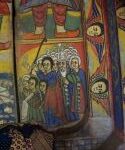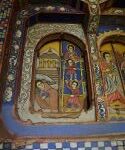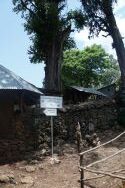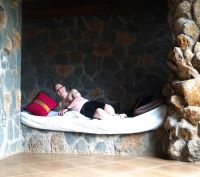It seems fitting that I’m spending my last day in Ethiopia here on Lake Tana exploring churches and monasteries, relaxing at a five-star hotel, and preparing to visit two museums in Addis Ababa on my way home.
Coming here from Gondar by car, I crossed into a different Ethiopia. Even though it is in the same province (Amhara) and only 180 K by car, on a paved highway, the trip through the mountains and across fields were green, something I hadn’t seen in my other areas, where the drought has been devastating (the US AID agent I met said his agency was feeding 2.9 million people), and the monsoons in any case provide a year’s worth of water. I went from the equivalent of Wyoming to Wisconsin, a transition made easier by the presence of lots of cows. The highway was also full of people walking (and some hitchhiking or waiting for the tuk-tuks which provide long distance travel, in their Sunday clothes) or at least covered with white shrouds, reflecting the Orthodox belief that Christ ascended in a white robe. It’s a colorful country for clothing. The small towns we passed through resembled, as I’ve suggested, 1990s China, complete with the Coca-Cola truck distributing one carton or two to the small shops dotting the street.
When I got to Lake Tana—the third largest lake in Africa (behind Victoria and Tanganyika), I went for a boat ride. The first “stop” was the outlet of the lake, which is the beginning of the Blue Nile (it’s pretty brown actually), as it begins its 5500 k descent to the Mediterranean, joining another stream at Khartoum, Sudan, where it forms the Nile.
 The Lake is the setting for over 20 monasteries and churches; we visited two dating from the 14th century, and by now I have some of the standard guide descriptions down. There’s a lot of symbolism: the church is round, reflecting alpha and omega; it has four doors for the four apostles (and one for men, one for women, one for priests, and one for the resurrection); the drum is bigger on one side (symbolizing the New Testament) than on the other (symbolizing the Old Testament—remember, the Ethiopian Church, as well as the royalty, has a link to Solomon), etc. The icons and stories painted on the churches are colorful, and tell stories, which were especially important when you had a literate clergy and an illiterate congregation. This church is one of many named for Mary, who holds a special place in the religion, and since it was her day in the Saint’s calendar, many people had come to the church to pray in the thatched church.
The Lake is the setting for over 20 monasteries and churches; we visited two dating from the 14th century, and by now I have some of the standard guide descriptions down. There’s a lot of symbolism: the church is round, reflecting alpha and omega; it has four doors for the four apostles (and one for men, one for women, one for priests, and one for the resurrection); the drum is bigger on one side (symbolizing the New Testament) than on the other (symbolizing the Old Testament—remember, the Ethiopian Church, as well as the royalty, has a link to Solomon), etc. The icons and stories painted on the churches are colorful, and tell stories, which were especially important when you had a literate clergy and an illiterate congregation. This church is one of many named for Mary, who holds a special place in the religion, and since it was her day in the Saint’s calendar, many people had come to the church to pray in the thatched church.

 The monastery we visited was founded in 1313, by a saint who also built a nunnery on another island. Only men were allowed in the monastery, and the self-sufficient congregation apparently allows only male animal species on the island. It had a museum with artifacts, both from the church—icons, chalices, and
The monastery we visited was founded in 1313, by a saint who also built a nunnery on another island. Only men were allowed in the monastery, and the self-sufficient congregation apparently allows only male animal species on the island. It had a museum with artifacts, both from the church—icons, chalices, and  crosses (there are at least three major varieties of crosses, all quite impressive), and crowns given by royalty and governors, signifying the close connection between church and state in historical Ethiopia; the emperors after all ruled by divine right.
crosses (there are at least three major varieties of crosses, all quite impressive), and crowns given by royalty and governors, signifying the close connection between church and state in historical Ethiopia; the emperors after all ruled by divine right.
I opted to splurge and spend my last night here (I’ll be on the 10 pm flight Monday out of Addis, and spend the next 24 hours airborne or in an airport somewhere) in a five-star resort that I could get used to. My room has a porch with a man cave, and as part of the reasonable price, I can have a fire lit; my bed is canopied, surrounded by a (needed) mosquito netting. It has a really nice pool, and I was able to get in over a quarter of a mile before I went to the (included) massage.
reasonable price, I can have a fire lit; my bed is canopied, surrounded by a (needed) mosquito netting. It has a really nice pool, and I was able to get in over a quarter of a mile before I went to the (included) massage.
I left the masseuse feeling 20 years younger and a foot taller, but I’ll bet that plane ride will close the age gap, and reduce the size.
In any case, I hope you’ve enjoyed vicariously my trip to Africa, and I will see many of you soon.